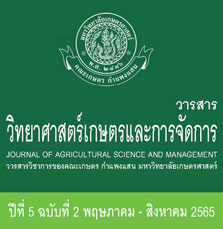Evaluation of Fruit Qualities and Beta-carotene in F3-Pach and F4-Paka Pumpkin Population Developed from Landrace Pumpkin Cultivars
Keywords:
population improvement, beta-carotene, percentage of dry weight, total soluble solids, landrace cultivarAbstract
Seventeen F3 and F4 pumpkin populations derived from landrace pumpkin cultivars were evaluated and compared with one landrace and one commercial cultivar. These populations were developed for enhancement in fruit qualities and beta-carotene content. From these population improvement, there were diversity in fruit quality traits as yellow, yellow orange and orange yellow flesh color. The total soluble solids, percentage of dry weight, flesh firmness and beta-carotene content were between 5.98 and 14.73 ◦Brix, 6.75 and 21.28 %, 0.85 and 2.86 kg/cm2 and 0.129-1.330 mg/100g FW, respectively. Principal component analysis based on 10 quality traits, 44 lines were selected with high beta-carotene content (> 0.7 mg/100g FW). This study indicated that pumpkin landrace cultivars could be used for pumpkin population improvement for quality diversity and development diverse from commercial cultivars and selection for new pumpkin varieties
References
กรมส่งเสริมการเกษตร. 2562. รายงานสถานการณ์การเพาะปลูกฟักทอง. 2561. แหล่งที่มา: http://production.doae.go.th/, 2 มีนาคม 2565.
ชเนษฎ์ ม้าลำพอง. 2562. หลักการปรับปรุงพันธุ์พืช. สำนักพิมพ์มหาวิทยาลัยเกษตรศาสตร์, กรุงเทพมหานคร. 342 หน้า.
นิติกร อินทวารี, กมล เลิศรัตน์ และพลัง สุริหาร. 2557. การตอบสนองต่อการคัดเลือกพันธุ์แบบหมู่ประยุกต์จำนวน 3 รอบเพื่อเพิ่มความต้านทานต่อโรคใบหงิกเหลืองในประชากรแตงกวา. แก่นเกษตร 42(4): 473-480.
ปณาลี ภู่วรกุลชัย. 2555. การประเมินความสัมพันธ์ทางพันธุกรรมของฟักทองพันธุ์ผสมเปิดด้วย SRAP marker. ปัญหาพิเศษปริญญาตรี, มหาวิทยาลัยเกษตรศาสตร์ วิทยาเขตกำแพงแสน.
ประกาศิต ดวงพาเพ็ง, พลัง สุริหาร และกมล เลิศรัตน์. 2558. การตอบสนองต่อการคัดเลือก 2 วิธีของลักษณะเมล็ดในประชากรข้าวโพดข้าวเหนียวสีม่วง. แก่นเกษตร 43(4): 635-642.
ภูวไนย ไชยชุมภู. 2562. การเปรียบเทียบพันธุ์ฟักทองลูกผสมชั่วรุ่นที่ 1 ที่เหมาะสมต่อการแปรรูปและการประเมินคุณภาพผลในสองฤดูกาล. วิทยานิพนธ์วิทยาศาสตรมหาบัณฑิต. มหาวิทยาลัยเกษตรศาสตร, กรุงเทพมหานคร. 83 หน้า.
อัญมณี อาวุชานนท์ และปณาลี ภู่วรกุลชัย. 2559. การประเมินความสัมพันธ์ทางพันธุกรรมของฟักทอง 29 สายพันธุ์ ด้วยเครื่องหมายดีเอ็นเอ AFLP. แก่นเกษตร 44 (2): 237-246.
อัญมณี อาวุชานนท์, พจนา สีมันตรา, บุพผา คงสมัย และธนัฐฐา พันธุ์เปรม. 2556. คุณภาพที่สำคัญบางประการของผลฟักทอง 12 สายพันธุ์. วารสารวิทยาศาสตร์เกษตร 43(3): 117-120.
อุทิศ สุภาพ. 2555. การใช้เทคสิคเนียร์อินฟราเรดสเปกโทรสโกปีในการหาปริมาณสารเบต้าแคโรทีนเพื่อใช้ในการปรับปรุงพันธุ์ฟักทอง. วิทยานิพนธ์วิทยาศาสตร์มหาบัณฑิต. มหาวิทยาลัยเกษตรศาสตร, กรุงเทพมหานคร. 108 หน้า
Harvey, W. J., G, D. Grant and J. P. Lammerink. 1997. Physical and sensory changes during the development and storage of buttercup squash. New Zealand Journal of Crop and Horticultural Science 25: 341-351.
Tanumihardjo, S. 2013. Carotenoids: Health effects. Encyclopedia of Human Nutrition 1: 292-297.
Nagata, M. and I, Yamashita. 1992. Simple method for simultaneous determination of chlorophyll and carotenoids in tomato fruit. Journal of the Japanese Society for Food Industry 39: 925-928.






